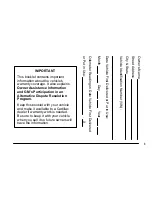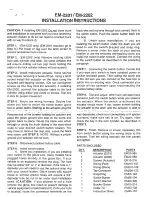
SAFETY
201
Passing Of Vehicles In An Oncoming
Intersection
The system could temporarily react to a vehicle
that crossed the range of the radar sensor, in an
oncoming intersection.
Passing Of Vehicles In An Oncoming Intersection
T
IRE
P
RESSURE
M
ONITORING
S
YSTEM
(TPMS)
The Tire Pressure Monitoring System (TPMS)
will warn the driver of a low tire pressure based
on the vehicle recommended cold tire pressure.
The tire pressure will vary with temperature by
about 1 psi (7 kPa) for every 12° F (6.5° C). This
means that when the outside temperature
decreases, the tire pressure will decrease. Tire
pressure should always be set based on cold
inflation tire pressure. This is defined as the tire
pressure after the vehicle has not been driven
for at least three hours, or driven less than
1 mile (1.6 km) after a three hour period. The
cold tire inflation pressure must not exceed the
maximum inflation pressure molded into the
tire sidewall. The tire pressure will also increase
as the vehicle is driven, this is normal and there
should be no adjustment for this increased
page 296 on how to properly inflate the
vehicle's tires.
The TPMS will warn the driver of a low tire
pressure if the tire pressure falls below the low
pressure warning limit for any reason, including
low temperature effects, or natural pressure
loss through the tire.
The TPMS will continue to warn the driver of low
tire pressure as long as the condition exists,
and will not turn off until the tire pressure is at
or above the recommended cold tire pressure
on the placard. Once the low tire pressure
warning (Tire Pressure Monitoring System
Warning Light) illuminates, you must increase
the tire pressure to the recommended cold tire
pressure in order for the Tire Pressure
Monitoring System Warning Light to turn off.
The system will automatically update and the
Tire Pressure Monitoring System Warning Light
will turn off once the system receives the
updated tire pressures. The vehicle may need to
be driven for up to 20 minutes above 15 mph
(24 km/h) in order for the TPMS to receive this
information.
For example, your vehicle may have a
recommended cold (parked for more than three
hours) tire pressure of 30 psi (207 kPa). If the
ambient temperature is 68° F (20° C) and the
measured tire pressure is 27 psi (186 kPa), a
temperature drop to 20° F (-7° C) will decrease
the tire pressure to approximately 23 psi
(159 kPa). This tire pressure is sufficiently low
enough to turn on the Tire Pressure Monitoring
System Warning Light. Driving the vehicle may
cause the tire pressure to rise to approximately
27 psi (186 kPa), but the Tire Pressure
Monitoring System Warning Light will still be on.
In this situation, the Tire Pressure Monitoring
System Warning Light will turn off only after the
tires are inflated to the vehicle’s recommended
6
21_FD_OM_EN_USC_t.book Page 201
















































